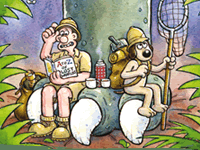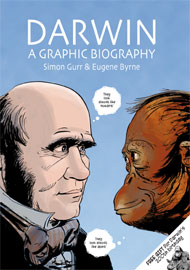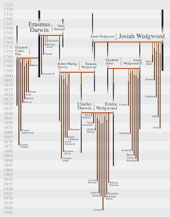|
||||||||||||||||||||||||||||||||||||||||||||||||||||
|
Timeline for the life of Charles Darwin.  Engraving of Charles Darwin based on a photograph by Elliott & Fry (c 1880) (University of Bristol Library, Special Collections). 1809 Born 12 February in Shrewsbury to Robert (son of Erasmus Darwin) and Susanna (daughter of Josiah Wedgwood). 1817 Starts school. Mother dies. 1818 Joins his older brother Erasmus as a boarder at Shrewsbury Grammar School. As a boy develops an interest in nature. 1825 Taken out of school by his father because of his poor grades. Spends summer accompanying his father on his rounds (he was the town's leading physician). Joins Erasmus at the University of Edinburgh to study medicine. 1826 Meets John Edmonstone, a freed slave from Guyana, who teaches him taxidermy. Joins the Plinian Society which debates natural sciences. Becomes friends with the zoologist Robert Grant. 1827 Abandons his medical degree – the lectures were dull and the practical surgery was horrific. Enrolled at Christ's College, Cambridge to study for the clergy. 1828 Takes up his place at Cambridge in January. Finds his studies no more suitable to his temperament than medicine. Enjoys collecting beetles, hanging out with 'a sporting set' and attending the lectures of John Henslow, Professor of Botany. 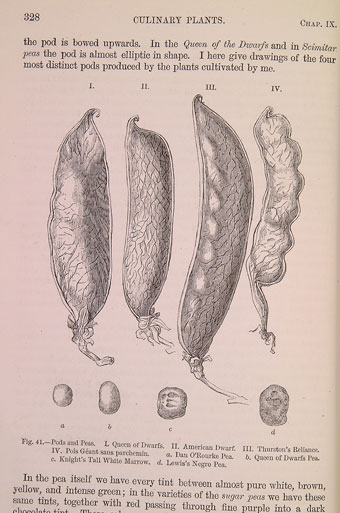 Peas and pods from Darwin's The Variation of Animals and Plants Under Domestication (1868) (University of Bristol Library, Special Collections). 1830 Ends his three-year romance with Fanny Owen. Henslow becomes his private tutor and mentor. 1831 Graduates. Spends part of the summer in Wales with the geologist Adam Sedgwick. On Henslow's recommendation is appointed gentleman-naturalist (an unpaid post) on the survey ship Beagle under the command of Captain Fitzroy. Departs from Devonport Docks in Plymouth on 27 December for five-year voyage. 1832 Ship reaches Brazil. Is appalled by the treatment of black slaves (his family were abolitionists) and falls out with FitzRoy over the issue. Sends his first collection of specimens back home to Henslow. 1833 Becomes fascinated by fossils of dead species, comparing them to comparable creatures that still exist and realising that they are linked. 1834 Contracts a serious fever during an overland exhibition – possibly the cause of his ill-health in later years. 1835 Experiences an earthquake. Gathers evidence of the geological shifts in the earth's surface – another sign that life is not fixed. Spends time in the Galapagos Islands. Only later realises the significance of the variation in species between the different islands. 1836 Studying islands in the Indian Ocean develops his theory of coral formation. Beagle docks at Falmouth 2 October. Arrives home, unannounced on the 4th. Starts classifying and distributing his specimens – 1,529 species preserved in spirit jars, 3,907 labelled "dry" items. 1837 Gives his first talk at the Royal Geological Society. Based on his observations, he says that the changes in the South American landmasses over time must have meant that animals had had to also change in order to survive. Some people deny any change has taken place. Others, like the geologist Charles Lyell, say that the original species must have died out and been replaced by new species by God. Lyell becomes a close colleague of Darwin despite their differences. Darwin moves to London in March. Ornithologist John Gould alerts him to the significance of the Galapagos finches. They are proof that species are changed as a result of variations in the environment. Finishes writing up his Beagle journal. 1838 First volume of Zoology of the Beagle is published. Busy filling notebooks with his observations and thoughts regarding transmutation (species change). Proposes marriage to his cousin Emma Wedgwood. 1839 Marries Emma on 29 January 1839. His journal is published (Voyage of the Beagle). First son, William Erasmus, born in December.  Orchestia Darwinii from Darwin's The Descent of Man (1871) (University of Bristol Library, Special Collections). 1841 Daughter Anne born. 1842 Family moves to Down House, bought for him by his father, in Downe, Kent in September. Daughter Mary dies in October, a few weeks after her birth. 1843 Daughter Katherine born. Fifth and final volume of Zoology of the Beagle published. Begins his long correspondence with his friend and colleague, the botanist Joseph Dalton Hooker. 1844 In January writes to Hooker, telling him about his theory of transmutation. Says it is 'like confessing a murder' to say he believes that species can change. In September tells Emma about his theory – has avoided this because is worried her religious views will find it shocking. 1845 Son George born. Revises Voyage of the Beagle to include a condemnation of slavery. 1846 Buys a strip of land adjacent to his property which becomes the place where he takes a daily walk to think through his theory. 1847 Daughter Elizabeth born. 1848 Son Francis born. His father dies. 1849 Family spends three months in Malvern where he undergoes water cure. 1850 Son Leonard born. 1851 Daughter Anne dies. Shakes what little remains of his religious faith. 1853 Receives the Royal Medal from the Royal Society. Has developed an interest in pigeon breeding as part of his research on transmutation. 1856 Invites four colleagues to Down House where he reads his draft paper on transmutation. Lyell encourages him to write up his work and publish it. The naturalist Alfred Russel Wallace is coming to similar conclusions and Darwin's friends do not want him to lose credit. Son Charles born. 1858 Receives Wallace's paper on species variation. Lyell and Hooker arrange for a joint paper by Wallace and Darwin to be read at the Linnean Society. This is the first time Darwin goes public with his theory. Darwin does not attend as his infant son Charles has just died. 1859 On the Origin of Species published. Sells out on day of publication and quickly reprinted. 1860 At a stormy meeting of the British Association for the Advancement of Science in Oxford, Darwin's supporters and detractors clash. Darwin's case is made by Hooker and T H Huxley. Darwin was not at the event himself. 1861 Henslow dies. 1862 Develops a passion for orchids and has a greenhouse built at Down House. 1864 Receives the Royal Society's Copley Medal, its highest honour. 1876 Writes autobiography which is published posthumously with a collection of his letters. 1877 Receives an honorary doctorate from University of Cambridge. 1881 His brother Erasmus dies. 1882 Dies 19 April. Given state funeral at Westminster Abbey. 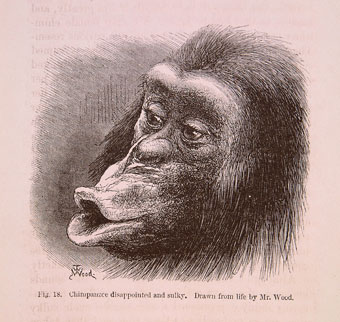 Sulky chimp from Darwin's The Expression of the Emotions in Man and Animals (1872) (University of Bristol Library, Special Collections). |
 |
||||||||||||||||||||||||||||||||||||||||||||||||||
